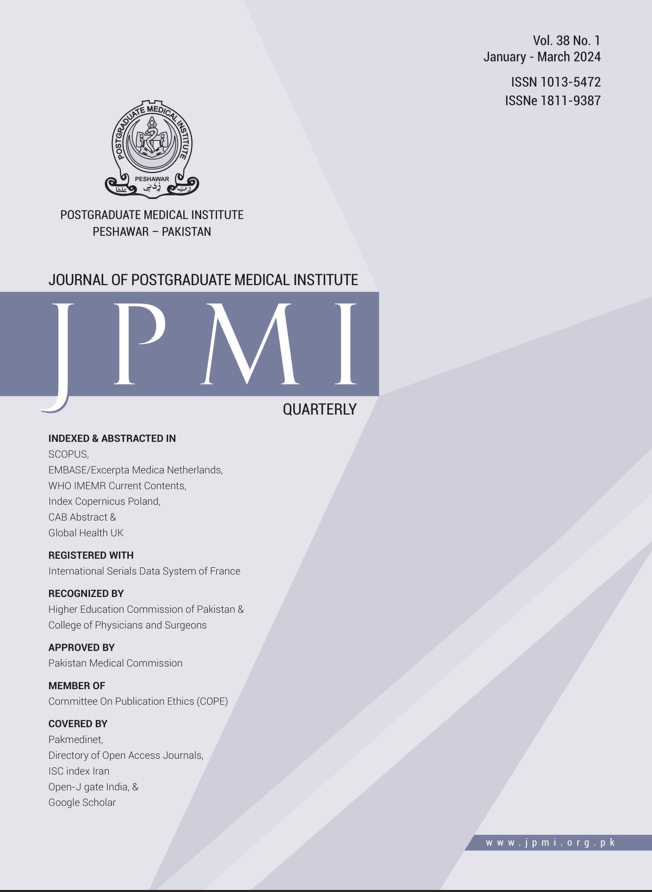EPIDEMIOLOGY OF SHAFT OF FEMUR FRACTURE IN A TERTIARY CARE HOSPITAL IN A DEVELOPING COUNTRY
Main Article Content
Abstract
Objective:
To describe the epidemiology of femur shaft fracture in a developing country and develop prevention policies considering the findings.
Methodology:
This retrospective epidemiological study included all patients with a femur fracture who were admitted between January 2021 and April 2023 at the orthopedic and trauma surgery department of Lady Reading Hospital, Peshawar, Pakistan. The patient’s medical records were retrospectively reviewed using electronic medical records in the Hospital information system (HIS). All patients with documented femur shaft fracture who were admitted and operated on with an interlocking nail during the study period, irrespective of age, were included.
Results:
A total of 288 patients were identified in HMIS that had AO and were included in this study. Mean age was 31.52 ± 15.475 SD (12-91). Male to female ratio was 295:52. According to AO classification, 27 patients had 32A1 injury, 45 patients had 32A2 injury, 74 patients had 32A3 injury, 16 patients had 32B1 injury, 44 patients had 32B2 injury, 22 patients had 32B3 injury, 18 patients had 32C1 injury, 15 patients had 32C2 injury and 27 patients had 32C3 injury. Different surgical options as well as the mode of fixation were used in the management of these fractures with missing data identification in 17% of patients.
Conclusion
Traumatic femur fracture are not uncommon injuries in developing countries which occur due to road traffic accidents and firearm injuries in majority of the cases.
Article Details
Work published in JPMI is licensed under a
Creative Commons Attribution-NonCommercial 2.0 Generic License.
Authors are permitted and encouraged to post their work online (e.g., in institutional repositories or on their website) prior to and during the submission process, as it can lead to productive exchanges, as well as earlier and greater citation of published work.
References
Agarwal-Harding KJ, Meara JG, Greenberg SL, Hagander LE, Zurakowski D, Dyer GS. Estimating the global incidence of femoral fracture from road traffic collisions: a literature review. J Bone Joint Surg Am. 2015;97(6):e31(1-9). DOI: 10.2106/JBJS.N.00314.
Ghouri SI, Asim M, Mustafa F, Kanbar A, Ellabib M, Al Jogol H, et al. Patterns, Management, and Outcome of Traumatic Femur Fracture: Exploring the Experience of the Only Level 1 Trauma Center in Qatar. Int J Environ Res Public Health. 2021;18(11):5916. DOI: 10.3390/ijerph18115916.
Pietu G, Lebaron M, Flecher X, Hulet C, Vandenbussche E. Epidemiology of distal femur fractures in France in 2011–12. Orthopaedics & Traumatology: Surgery & Research. 2014 Sep 1;100(5):545-8. DOI: 10.1016/j.otsr.2014.06.004.
Burç H, Atay T, Demirci D, Baykal YB, Kirdemir V, Yorgancigil H. The Intramedullary Nailing of Adult Femoral Shaft Fracture by the Way of Open Reduction is a Disadvantage or Not? Indian J Surg. 2015;77(Suppl 2):583-8.
Dinesh Mohan, Abhaya Jha, Samradh S. Chauhan. Future of road safety and SDG 3.6 goals in six Indian cities. IATSS Research. 2021;45:12–18. DOI: 10.1016/j.iatssr.2021.01.004.
Pouramin P, Li CS, Busse JW, Sprague S, Devereaux PJ, Jagnoor J, et al. Delays in hospital admissions in patients with fractures across 18 low-income and middle-income countries (INORMUS): a prospective observational study. Lancet Glob Health. 2020;8(5):711-20. DOI: 10.1016/S2214-109X(20)30067-X.
Ibrahim YB, Mohamed AY, Ibrahim HS, Mohamed AH, Cici H, Mohamed YG, Yasin NA, May H. Risk factors, classification, and operative choices of femur fractures at a Tertiary Hospital: first report from Somalia. Sci Rep. 2023;13(1):12847. DOI: 10.1038/s41598-023-39671-9.
Enninghorst N, McDougall D, Evans JA, Sisak K, Balogh ZJ. Population-based epidemiology of femur shaft fractures. J Trauma Acute Care Surg. 2013;74(6):1516-20. DOI: 10.1097/TA.0b013e31828c3dc9.
Kushida Y, Omori K, Muramatsu KI, Nagasawa H, Takeuchi I, Jitsuiki K, et al. Epidemiology of a Femur Shaft Fracture in an Acute Critical Care Center in a Rural Area of Japan. Open J Orthop.. 2019;13(1). DOI: 10.2174/1874325001913010295.
AlTurki AA, AlAqeely KS, AlMugren TS, AlZimami IS. Analysis of femoral fracture post motor vehicle accidents. Saudi Med J. 2019;40(1):41-4. DOI: 10.15537/smj.2019.1.21547
Anyaehie UE, Ejimofor OC, Akpuaka FC, Nwadinigwe CU. Pattern of femoral fractures and associated injuries in a Nigerian tertiary trauma centre. Niger J Clin Pract. 2015;18(4):462-6.
Khan I, Shakeel M, Usmani JA, Hasan SA. Emerging Trends of Intentional Firearm Injuries in Northern India: A Study. J Clin Diagn Res. 2016;10(10):HC01-4.
Barber C, Cook PJ, Parker ST. The emerging infrastructure of US firearms injury data. Prev Med. 2022;165(Pt A):107129. DOI: 10.1016/j.ypmed.2022.107129.
Umer M, Niazi AK, Hussain D, Ahmad M. Treatment of acute fractures of the femoral shaft with reamed intramedullary interlocking AO nails. J Pak Med Assoc. 2004;54(8):423-7.
Salminen ST, Pihlajamäki HK, Avikainen VJ, Böstman OM. Population based epidemiologic and morphologic study of femoral shaft fractures. Clin Orthop Relat Res. 2000;(372):241-9.
Shafi MK, Ahmed N, Khan AH, Aziz A. Results of fracture union in closed reamed interlocking nail in fractures of femur. Pak J Med Sci 2008;24(5):698-701.
Kandemir U, Janghala A. Difficult Diaphyseal Femur Fractures: Pearls and Pitfalls. Instr Course Lect. 2023;72:405-27.
Meinberg EG, Agel J, Roberts CS, Karam MD, Kellam JF. Fracture and Dislocation Classification Compendium-2018. J Orthop Trauma. 2018;32 Suppl 1:S1-170. DOI: 10.1097/BOT.0000000000001063.
Bonafede M, Espindle D, Bower AG. The direct and indirect costs of long bone fractures in a working age US population. J Med Econ. 2013;16(1):169-78. DOI: 10.3111/13696998.2012.737391.


